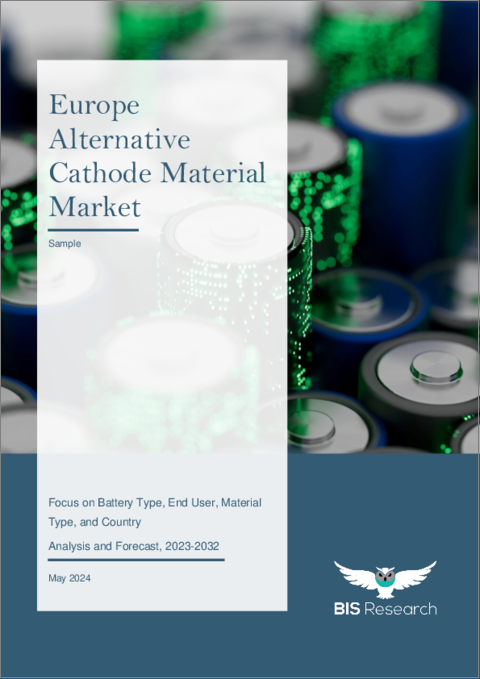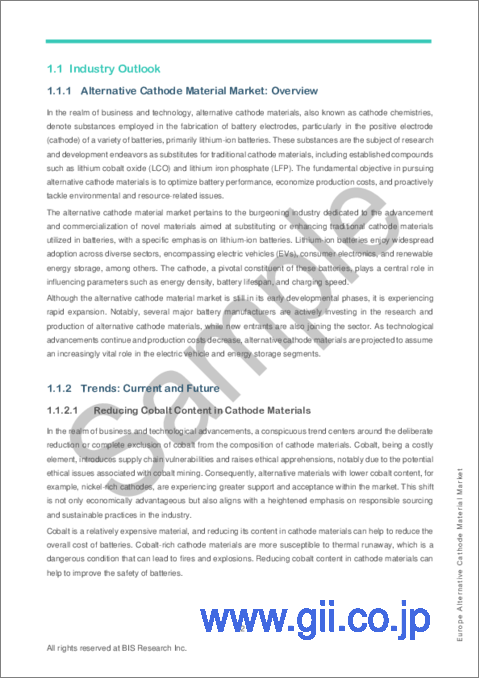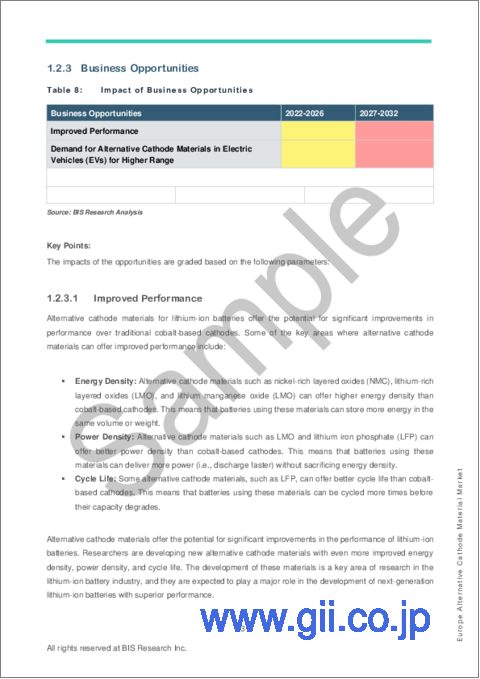|
|
市場調査レポート
商品コード
1481277
欧州の代替カソード材料市場:電池タイプ・エンドユーザー・材料タイプ・国別の分析・予測 (2023-2032年)Europe Alternative Cathode Material Market: Focus on Battery Type, End User, Material Type, and Country - Analysis and Forecast, 2023-2032 |
||||||
カスタマイズ可能
|
|||||||
| 欧州の代替カソード材料市場:電池タイプ・エンドユーザー・材料タイプ・国別の分析・予測 (2023-2032年) |
|
出版日: 2024年05月20日
発行: BIS Research
ページ情報: 英文 74 Pages
納期: 1~5営業日
|
全表示
- 概要
- 図表
- 目次
英国を除く欧州の代替カソード材料の市場規模は、2023年の54億米ドルから、予測期間中は9.01%のCAGRで推移し、2032年には117億4,000万米ドルに達すると予測されています。
代替カソード材料市場の成長は、より高いエネルギー密度を提供するリチウム電池への需要の増加によって促進されると予想されています。さらに、代替カソード材料に関連する費用の低減が見込まれることも、市場の成長に大きく寄与するとみられます。
| 主要市場統計 | |
|---|---|
| 予測期間 | 2023-2032年 |
| 2023年評価 | 54億米ドル |
| 2032年予測 | 117億4,000万米ドル |
| CAGR | 9.01% |
欧州の代替カソード材料市場は、いくつかの重要な要因によって大きな成長を遂げています。より高いエネルギー密度を持つリチウム電池の需要が高まる中、これらの要件を満たすことができる代替カソード材料が急務となっています。また、同地域は持続可能性に重点を置き、従来のカソード材料への依存を減らしていることが、市場の成長をさらに後押ししています。さらに、技術と製造プロセスの進歩が、代替カソード材料の実現可能性と費用対効果を高めています。環境に優しい実践を促進し、革新的な電池技術の採用を奨励する厳しい規制も、市場成長のための環境を整えています。欧州の持続可能性と技術革新へのコミットメントにより、代替カソード材料市場は、電池業界の進化する需要への対応を目指すメーカーや利害関係者に有利な機会を提供しています。
市場セグメンテーション
セグメンテーション1:電池タイプ別
- リチウムイオン電池
- 鉛蓄電池
- その他
セグメント2:エンドユーザー別
- 自動車
- CE製品
- 電動工具
- エネルギー貯蔵システム (ESS)
- その他
セグメンテーション3:材料タイプ別
- リチウムニッケルマンガンコバルト酸化物 (NMC)
- リチウムニッケルコバルトアルミニウム酸化物 (NCA)
- リン酸鉄リチウム (LFP)
- マンガン酸リチウム (LMO)
- その他
セグメンテーション4:国別
- ドイツ
- スペイン
- ポーランド
- ハンガリー
- その他
当レポートでは、欧州の代替カソード材料の市場を調査し、業界の動向、進行中のプログラム、特許動向、市場成長促進要因・抑制要因、市場規模の推移・予測、各種区分別の詳細分析、競合情勢、主要企業のプロファイルなどをまとめています。
目次
エグゼクティブサマリー
調査範囲
第1章 市場
- 業界展望
- 代替カソード材料市場:概要
- 動向:現在と将来
- サプライチェーンネットワーク
- エコシステム/進行中のプログラム
- 事業力学
- 事業促進要因
- 事業上の課題
- 事業機会
- カソード材料の採掘
- 各種カソードの使用例
- 主要バッテリー鉱物の比較分析
- 分析:代替カソード材料が必要な理由
第2章 地域
- 欧州
- 欧州:国レベルの分析
- 英国
第3章 市場:競合ベンチマーキングと企業プロファイル
- 競合ベンチマーキング
- 市場企業ランキング
- 企業プロファイル
- BASF SE
- Johnson Matthey
- Umicore N.V.
第4章 調査手法
- データソース
- BASF SE
- Johnson Matthey
- Umicore N.V.
- 市場予測と予測
- データ予測およびモデリング
List of Figures
- Figure 1: Europe Alternative Cathode Material Market, $Billion, 2022-2032
- Figure 2: Europe Alternative Cathode Material Market (by Battery Type), $Billion, 2022-2032
- Figure 3: Europe Alternative Cathode Material Market (by End User), $Billion, 2022-2032
- Figure 4: Europe Alternative Cathode Material Market (by Material Type), $Billion, 2022-2032
- Figure 5: Alternative Cathode Material Market (by Region), $Billion, 2022
- Figure 6: Alternative Cathode Material Market Supply Chain
- Figure 7: Global Competitive Benchmarking, 2022
- Figure 8: BASF SE: Product Portfolio
- Figure 9: Johnson Matthey: Product Portfolio
- Figure 10: Umicore N.V.: Product Portfolio
- Figure 11: Data Triangulation
- Figure 12: Top-Down and Bottom-Up Approach
List of Tables
- Table 1: Europe Alternative Cathode Material Market Overview
- Table 2: Key Companies Profiled
- Table 3: Key Consortiums and Associations
- Table 4: Regulatory Bodies
- Table 5: Programs by Research Institutions and Universities
- Table 6: Impact of Business Drivers
- Table 7: Impact of Business Restraints
- Table 8: Impact of Business Opportunities
- Table 9: Comparative Analysis of Key Battery Minerals
- Table 10: Alternative Cathode Material Market (by Region), Kiloton, 2022-2032
- Table 11: Alternative Cathode Material Market (by Region), $Billion, 2022-2032
- Table 12: Alternative Cathode Material Market Player Ranking, 2022
Introduction to Europe Alternative Cathode Material Market
The Europe alternative cathode material market (excluding U.K.) was valued at $5.40 billion in 2023, and it is expected to grow with a CAGR of 9.01% during the forecast period 2023-2032 to reach $11.74 billion by 2032. The growth of the alternative cathode material market is expected to be fueled by increasing demand for lithium batteries offering greater energy densities. Moreover, the anticipated lower expenses associated with alternative cathode materials are likely to contribute significantly to the market's growth.
| KEY MARKET STATISTICS | |
|---|---|
| Forecast Period | 2023 - 2032 |
| 2023 Evaluation | $5.40 Billion |
| 2032 Forecast | $11.74 Billion |
| CAGR | 9.01% |
Market Introduction
The Europe alternative cathode material market is witnessing significant growth driven by several key factors. With the rising demand for lithium batteries with higher energy densities, there's a pressing need for alternative cathode materials that can meet these requirements. The region's focus on sustainability and reducing dependence on traditional cathode materials further propels market growth. Additionally, advancements in technology and manufacturing processes are enhancing the feasibility and cost-effectiveness of alternative cathode materials. Furthermore, stringent regulations promoting eco-friendly practices and encouraging the adoption of innovative battery technologies are creating a conducive environment for market growth. With Europe's commitment to sustainability and innovation, the alternative cathode material market presents lucrative opportunities for manufacturers and stakeholders aiming to address the evolving demands of the battery industry.
Market Segmentation:
Segmentation 1: by Battery Type
- Lithium-Ion Batteries
- Lead-Acid Batteries
- Others
Segmentation 2: by End User
- Automotive
- Consumer Electronics
- Power Tools
- Energy Storage Systems (ESS)
- Others
Segmentation 3: by Material Type
- Lithium Nickel Manganese Cobalt Oxide (NMC)
- Lithium Nickel Cobalt Aluminium Oxide (NCA)
- Lithium Iron Phosphate (LFP)
- Lithium Manganese Oxide (LMO)
- Others
Segmentation 4: by Country
- Germany
- Spain
- Poland
- Hungary
- Rest-of-Europe
How can this report add value to an organization?
Product/Innovation Strategy: In the realm of alternative cathode material, technological advancements are transforming agricultural landscapes to create winning products, choose the right unmet needs, target the right customer group, and compete with substitute products. The product segment helps the readers understand the different types of alternative cathode materials. Also, the study provides the readers with a detailed understanding of the Europe alternative cathode material market based on application and product.
Growth/Marketing Strategy: The alternative cathode material market has witnessed remarkable growth strategies by key players. Business expansions, collaborations, and partnerships have been pivotal. Companies are venturing into foreign markets, forging alliances, and engaging in research collaborations to enhance their technological prowess. Collaborative efforts between tech companies and agricultural experts are driving the development of cutting-edge monitoring tools. Additionally, strategic joint ventures are fostering the integration of diverse expertise, amplifying the market presence of these solutions. This collaborative approach is instrumental in developing comprehensive, user-friendly, and efficient alternative cathode materials.
Competitive Strategy: In the competitive landscape of alternative cathode material, manufacturers are diversifying their product portfolios to cover various applications. Market segments include battery type, end-user, and material type. Competitive benchmarking illuminates the strengths of market players, emphasizing their unique offerings and regional strengths.
Table of Contents
Executive Summary
Scope of the Study
1 Markets
- 1.1 Industry Outlook
- 1.1.1 Alternative Cathode Material Market: Overview
- 1.1.2 Trends: Current and Future
- 1.1.2.1 Reducing Cobalt Content in Cathode Materials
- 1.1.2.2 Shift to Lithium Iron Phosphate (LFP) Batteries
- 1.1.2.3 Shift toward Electric Vehicles
- 1.1.3 Supply Chain Network
- 1.1.3.1 Mining and Processing
- 1.1.3.2 Material Production
- 1.1.3.3 Cathode Production
- 1.1.3.4 Battery assembly
- 1.1.4 Ecosystem/Ongoing Programs
- 1.1.4.1 Consortiums and Associations
- 1.1.4.2 Regulatory Bodies
- 1.1.4.3 Programs by Research Institutions and Universities
- 1.2 Business Dynamics
- 1.2.1 Business Drivers
- 1.2.1.1 Concerns about Cobalt Availability
- 1.2.1.2 Rising Demand for Lithium-Ion Batteries with Higher Energy Densities
- 1.2.1.3 Lower Cost of Alternate Cathode Materials
- 1.2.1.4 Increasing Renewable Energy Integration
- 1.2.2 Business Challenges
- 1.2.2.1 Limited Commercialization
- 1.2.2.2 Supply Chain Uncertainties
- 1.2.2.3 Regulatory and Safety Concerns
- 1.2.3 Business Opportunities
- 1.2.3.1 Improved Performance
- 1.2.3.2 Demand for Alternative Cathode Materials in Electric Vehicles (EVs) for Higher Range
- 1.2.1 Business Drivers
- 1.3 Mining of Cathode Materials
- 1.4 Use Cases of Various Cathode Types
- 1.5 Comparative Analysis of Key Battery Minerals
- 1.6 Analysis: Why is There a Need for Alternative Cathode Materials?
2 Regions
- 2.1 Europe
- 2.1.1 Europe: Country-Level Analysis
- 2.1.1.1 Germany
- 2.1.1.2 Spain
- 2.1.1.3 Poland
- 2.1.1.4 Hungary
- 2.1.1.5 Rest-of-Europe
- 2.1.1 Europe: Country-Level Analysis
- 2.2 U.K.
3 Markets - Competitive Benchmarking & Company Profiles
- 3.1 Competitive Benchmarking
- 3.2 Market Player Ranking
- 3.3 Company Profiles
- 3.3.1 BASF SE
- 3.3.1.1 Company Overview
- 3.3.1.2 Product Portfolio
- 3.3.1.3 Analyst View
- 3.3.1.3.1 Regions of Growth
- 3.3.2 Johnson Matthey
- 3.3.2.1 Company Overview
- 3.3.2.2 Product Portfolio
- 3.3.2.3 Analyst View
- 3.3.2.3.1 Regions of Growth
- 3.3.3 Umicore N.V.
- 3.3.3.1 Company Overview
- 3.3.3.2 Product Portfolio
- 3.3.3.3 Analyst View
- 3.3.3.3.1 Regions of Growth
- 3.3.1 BASF SE
4 Research Methodology
- 4.1 Data Sources
- 4.1.1 Primary Data Sources
- 4.1.2 Secondary Data Sources
- 4.1.3 Data Triangulation
- 4.2 Market Estimation and Forecast
- 4.2.1 Factors for Data Prediction and Modeling





